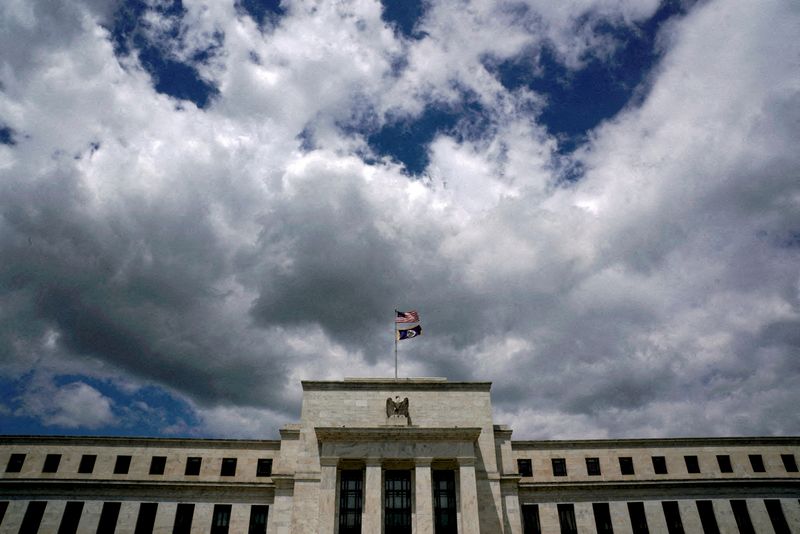By Michael S. Derby
NEW YORK (Reuters) -The Federal Reserve is preparing in short order to slow the rate at which it sheds Treasury securities from its balance sheet, with policymakers generally favoring cutting the recent pace by roughly half in an effort to extend the process of shrinking holdings and reducing the risk of market trouble.
According to minutes released on Wednesday of the Fed's latest policy meeting, held on March 19-20, officials are thinking about the future of their balance sheet winddown, known as quantitative tightening, or QT, with an eye toward the 2017 to 2019 period, when they last engaged in a similar process that ended up with significant market tumult.
Due to that experience, officials last month “broadly assessed it would be appropriate to take a cautious approach," and "the vast majority of participants thus judged it would be prudent to begin slowing the pace of runoff fairly soon.”
The Fed is currently allowing up to $60 billion per month in Treasury bonds and up to $35 billion per month in mortgage bonds to mature and not be replaced as part of the QT agenda.
“Participants generally favored reducing the monthly pace of runoff by roughly half from the recent overall pace,” the minutes said, and officials aim to do this by tweaking the runoff of Treasuries and leaving in place the cap on mortgage bond runoff. For a variety of reasons, the Fed has struggled to see mortgages run off at the desired pace. And as it ultimately wants as close to an all-Treasuries securities portfolio as it can get, it's government securities that will see the biggest effect in the looming taper.
By slowing the pace of the contraction, the minutes said officials believe they may gain some flexibility in how far they can reduce overall holdings, with the minutes noting "the decision to slow the pace of runoff does not mean that the balance sheet will ultimately shrink by less than it would otherwise."
Capital Economics economists said in a note that against the $95 billion monthly cap over the last 12 months the central bank had averaged a $76 billion per month drawdown, with the shortfall tied to mortgages. Based on the guidance in the minutes, "officials appear to be considering cutting the Treasury-specific run-off to $30 billion per month," and given current levels of banking sector reserves, a reduced-speed QT will likely run for another year, the research firm said.
As for when the Fed will shift gears, J.P. Morgan economist Michael Feroli said “we continue to believe that the committee will announce a halving of the Treasury cap at the next FOMC meeting in early May, with implementation occurring in mid-May.”
RUNOFF REVISIONS
Fed officials had to a large degree already hinted at the planning effort revealed in the meeting minutes. The current QT process has sought to unwind a massive expansion in Fed holdings that kicked off with the arrival of the coronavirus pandemic.
Starting in the spring of 2020, the Fed aggressively bought Treasury and mortgage securities, first to steady troubled markets and then to provide stimulus when the federal funds rate was at near zero levels and could be cut no further.
The purchases caused the size of Fed holdings to more the double, with the balance sheet moving from $4.4 trillion in March 2020 to $9 trillion by the summer of 2022. Later that year, the Fed embarked on its QT effort which has allowed the Fed to shed about $1.5 trillion from its holdings.
The Fed’s goal for the drawdown is to drain liquidity from the financial system, moving from what it views as abundant reserves to ample ones. Fed officials have been unable to define what level “ample” will be but believe it leaves enough liquidity in the financial system to allow for normal volatility in money market rates and firm central bank control over the federal funds rate.
Ahead of the Fed meeting, officials had been hinting at what is to come, and what the slowdown in the runoff might accomplish.
“A slower but still meaningful pace will provide more time for banks and money market participants to redistribute liquidity and for the FOMC to assess liquidity conditions,” Dallas Fed President Lorie Logan said on April 4. Before taking the leadership spot at the Dallas Fed, Logan ran the process of implementing monetary policy at the New York Fed.
Speaking after the FOMC meeting last month Fed Chair Jerome Powell said officials are taking the debate in discrete steps. For now, “what we’re really looking at is slowing the pace of runoff,” Powell said on March 20. “we’re not discussing all the many other balance sheet issues. We will discuss those in due course,” he said.
